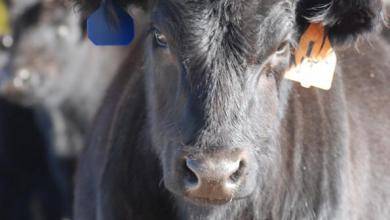It’s a time-honored tradition — visually assessing potentialreplacement heifers to identify the oldest and largest candidates. But time has also proven that age and size can’t guarantee fertility.
Some producers may have recognized that continual selection of the heaviest heifers at weaning inadvertently increased cow size over time. On the other hand, consistently choosing lightweight heifers reaching puberty at an early age could decrease average age of puberty and increase the risk of mating with a co-pastured bull.
Until science perfects a definitive DNA fertility test, beef producers can pursue optimum reproduction results by obtaining a reproductive tract score (RTS) on potential replacement heifers 4-6 weeks before breeding season. RTS values can help predict reproductive performance of yearling heifers, especially for pregnancy rates in synchronized breeding and pregnancy rates at the end of the breeding season. Scores are ranked from 1 (immature) through 5 (cycling).
RTS values are gauged through rectal palpation of the uterine horns and ovaries. Sexual maturity of a 10- to 12-month-old heifer is gauged based on ovarian follicular development and palpable size of the reproductive tract. An RTS chart of standard values is used to assign a maturity rating (see table below).
RTS values are based on the size, length, height and width of the uterine horn, as well as the size of antral follicles.
• Heifers with small, toneless uterine horns and small ovaries rate an RTS of 1.
• Heifers with an RTS 2 are considered to be closer to cycling than those with a 1 rank.
• RTS 3 heifers are gauged to be on the verge of cycling based on slight uterine tone, in addition to the presence of follicles.
• An RTS 4 value presumes cycling, which is indicated by good uterine tone and size, as well as follicular growth.
• An RTS 5 heifer has all the characteristics of a 4, plus a palpable corpus luteum, the hormone-secreting structure that develops in an ovary after an ovum has been discharged.

RTS system improves conception rate
“Very few producers know the pubertal status of heifers prior to breeding season,” says Robert A. Cushman, a research physiologist in the reproduction research unit at USDA’s U.S. Meat Animal Research Center in Clay Center, NE. “Observing behavioral estrus has been a common means of assessing pubertal readiness. However, that is very labor-intensive. Genetic technologies aren’t yet advanced enough to provide an accurate, cost-effective genetic test for fertility.
“By using the RTS system, beef producers can potentially improve conception rates in heifers by 15%-20%. A veterinarian can assess several hundred heifers in a day at a cost likely to be between $3-$5/head.”
In a 2009 study, Cushman found that antral follicle count (the number of fluid-filled follicles in the ovaries) was a valid indicator of fertility and reproductive age in cattle. Crossbred beef heifers with fewer than 15 (low) follicles detected by ultrasonography had lower pregnancy rates at the end of a 60-day breeding season than heifers with more than 25 (high) follicles detected by ultrasonography.
“Like puberty and RTS scores, antral follicle count seems to be an indicator of fertility. Based on repeat breeder-cow results, it may even be an early indicator of how these cows will perform in later life,” Cushman says.
In order to calve at 24 months of age, heifers must reach puberty by 15 months. However, up to 35% of all beef heifers don’t reach puberty at this age. Since first-service conception rates for heifers bred on their first heat are lower than those of heifers bred on their second or subsequent heat, heifers should reach puberty 1-3 months prior to the average age at which they’re bred. RTS works well in assessing pubertal maturity prior to breeding.
“Typically, heifers need to be 10-12 months of age before the RTS evaluation is done. The assessment can be completed a month or two before breeding starts,” Cushman says.
A 2009 study (D.E. Holm, P.N. Thompson, and P.C. Irons, “The Value of Reproductive Tract Scoring As a Predictor of Fertility and Production Outcomes in Beef Heifers”) found that heifers with an RTS of 5 had a greater pregnancy rate and earlier median calving day than heifers with an RTS of 1. In that same study, heifers with a score of 1 that produced a calf in their first season still had a greater risk of failing to become pregnant in their second breeding season, even with another year of growth.
“Since heifers that calve in their first estrous cycle have proven to be more productive throughout their lifetime than those that don’t conceive until their second or third cycle, taking a few minutes to assess each heifer’s pubertal maturity to select the heifers most likely to become pregnant in that first estrus can provide lifetime benefits,” Cushman says.
A trained veterinarian can assess a heifer’s reproductive tract score in 15-20 seconds through palpation. If beef producers prefer to conduct their own assessment, training to learn the procedure is an option. “If you’re learning artificial insemination, you can probably learn how to assess the reproductive tract,” Cushman adds.
RTS values can be obtained through palpation or ultrasonography. But the latter is more time-consuming and costly, and it probably provides more data than breeders need to make heifer replacement decisions, Cushman says.
He adds that beef producers should bear in mind that numerous studies have reported both between-breed and within-breed differences in age and weight at puberty.
“To achieve optimum production levels, it’s important to know the relationships between puberty traits and measures of productivity for effective use of selection, heterosis [hybrid vigor] and complementarity. Breed differences, sire and dam effects within a breed and heterosis all contribute to genetic control of age at puberty,” Cushman says.
Additional information about RTS and beef heifer development is available here.
Date: Jun 28, 2013 Source: BeefMagazine
